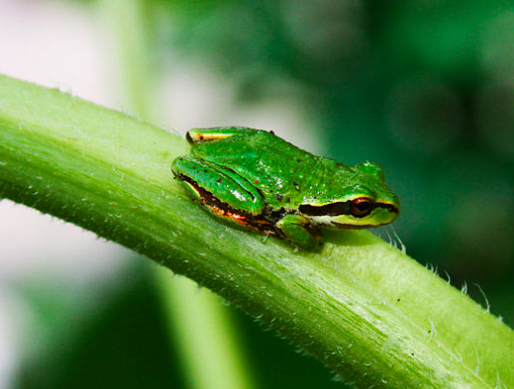Why Frogs Ribbit

The names we give to animal sounds vary widely as you move from area to area. The reason, generally, has little to do with the animals themselves — the sound a rooster makes is roughly the same whether that rooster lives in the United States, Germany, or China. But because the labels we give their noises are onomatopoetic approximations — we put their sounds into our “words — a rooster in the US says “cock-a-doodle-doo” while in Germany it goes “kikeriki” (with an emphasis on that last syllable) and in China, it’s “wo-wo-wo.”
The same is true for frogs. In Germany, locals attest that the frog says “quaken.” In China, the frog’s croak, transliterated, would be something like “qua-qua.” And if you grew up in the United States, you probably think that frogs near you say “ribbit.” That’s the word people in the United States use to describe the sound.
But those Americans are probably wrong — and Hollywood is to blame.
The Pacific tree frog, above, is a species of frog which lives up and down the North American Pacific coast, ranging as far north as the extreme southern tip of Alaska. Depending on what taxonomy one goes by, the species range down to Baja California and somewhat eastward toward the Sierra Nevada mountains. Alternative taxonomies may categorize these frogs into three distinct species (one per region), but either way, one thing is for sure: their males, when it’s time to look for a mate, all make the same sound. You can listen to that sound here.
It kind of sounds like “ribbit,” right?
That “ribbit” sound is what’s called an “advertisement call.” Frogs need to reproduce and to do so, male frogs need to make two things clear: first, that they’re open for business and second, that this lilypad is theirs and other male frogs should stay away. The “ribbit” serves that dual purpose — it tells female Pacific tree frogs that this is a good place to lay her eggs, and it tells male Pacific tree frogs to go find their own domain. However, that message is only intended for frogs of the same (or compatible) species. No one benefits if a frog’s croaking noise attracts the wrong species of female frog or deters a different species of male.
The good news, if you’re a frog, is that it’s pretty easy to keep all of these frog noises straight. As it turns out, different species of frogs have distinct advertisement calls. The bad news, if you’re a human, is that most frogs don’t actually ribbit, despite what we think.
So where’d the mix-up happen? The movies. If you watch a movie, particularly one from an era where films were made on a Hollywood studio lot, and you hear frogs, you’ll hear ribbits. That’s because the background noises needed to come from somewhere else — and whatever was local was good enough. As Oregon State University’s Animal Bioacoustics blog explains, Pacific tree frogs were “regularly featured in movies because early sound designers could go out to the ponds in California, even in the Hollywood area, and easily record the sound of the chorus. It was more a factor of convenience than desire.”
As a result, the Pacific tree frog’s advertisement call became a familiar one. For those whose weren’t otherwise serenaded with a chorus of frog croaks from locally-sourced frogs, movies provided nearly 100% of their frog sound knowledge. As they watched movies, they were exposed to the “ribbit” of the Pacific tree frog and started incorporating it into other places frogs may be, such as Old MacDonald’s Farm — despite the fact that few other frogs actually “ribbit.” The “frog goes ribbit” idea spread, and today, Americans think that a frog’s ribbit is universal.
Bonus fact: According to various fables, if you put a frog in a pot of water and slowly bring it to a boil, the frog won’t realize that it is in danger and will boil to death. Like the ribbit, this isn’t true. In 1995, George R. Zug, then the curator of reptiles and amphibians at the National Museum of Natural History, told Fast Company that any such fable is “[baloney]” and “if a frog had a means of getting out, it certainly would get out.” Harvard professor Doug Melton, in that same article, corroborated Zug’s take: “If you put a frog in boiling water, it won’t jump out. It will die. If you put it in cold water, it will jump before it gets hot — they don’t sit still for you.”
From the Archives: Freezing to Un-Death: The frogs that freeze themselves for the winter — and then come back.
